
On a warm summer day, turning on a ceiling fan provides immediate relief from heat and humidity. It also consumes much less electricity than an air-conditioning unit. In recent years, smart ceiling fans have arrived to address other areas of user comfort, including voice activation, mobile app controls, and thermostat compatibility.
To understand the full consumer value proposition of smart fans, we spoke to Mr. Manoj Meena, CEO & Founder of Atomberg Technologies. With over one million units sold, this Mumbai, India-based engineering company has carved a niche for itself in the smart ceiling fan segment.
Atomberg fans use a brushless DC motor design (BLDC) – a huge step up over conventional induction motors. What goes inside their products is an assortment of advanced development boards and a proprietary AtomSense smart electronics algorithm. Combined together, all these components bring noiseless, smart, energy-efficient operation to the ceiling fans.
What Is a Smart Ceiling Fan?
A smart ceiling fan is an IoT-enabled consumer product, which enables the device operations using multiple user interaction modes: remote control-operated, voice-activated, mobile app-based, and possibly, AI and other self-learning mechanisms. Having these extra features would clearly call for a complete redesign of existing fan-making technologies.
At its core, a smart ceiling fan uses brushless DC motor design (BLDC), which turns the very induction motor concept on its heel. You don’t just wait for the electric current in the fan rotor to produce the desired magnetic fields. Says Manoj: “[You add a] microcontroller which senses the rotor position continuously in real time and does the computation. What computation means here is that we are exciting the copper winding in such a way that the motor is rotating smoothly without creating noise and very efficiently. And that’s the reason we are able to achieve 28 W wattage compared to traditional fans, which operate between 75 to 80 watts.“
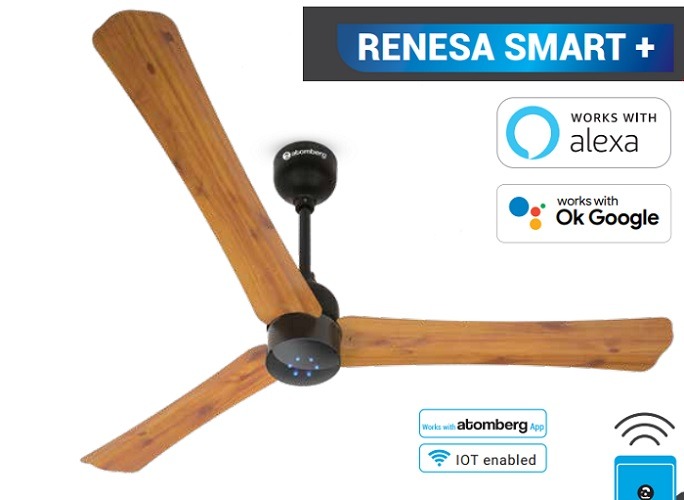
For Atomberg, BLDC design sits at the core of their smart fan concept, which allows them to convey the advantage of much higher energy efficiency and smooth operations. Atomberg’s Renesa Smart+ ceiling fans come with smart features, including Alexa and Google Assistant integration, as well as operational compatibility with an iOS and Android app. But to have these smart features enabled is really an afterthought. The crux of the innovation of a smart fan really lies in its BLDC design.
Manoj further adds: “Basically, you need to sense the position of the rotor, which is made of permanent magnets. That is really a new thing because induction motors have no magnets. And we need to sense the location where the magnets are. Where is my North Pole? Where is my South Pole? For that, I need to sense the rotor position in real time, which requires sophisticated hardware and mechanical electronic hardware. With Atomberg ceiling fans, we are having an LED interface in all our products.”
Components of Smart Ceiling Fans
The components of a typical smart ceiling fan are outlined below based on Atomberg’s proprietary design. There are a number of evaluation board and power electronics components which work together to create the final assembly.
For example, the following is a Wi-Fi module called “TYWE1S” by Tuya, a leading network module creator for electronic products. It supports a highly integrated wireless RF chip, ESP8266EX by Espressif, the maker of ESP32 boards, and DRV10983, a BLDC motor driver component, by Texas Instruments. The former’s objective is to serve as a Wi-FI SoC for the smart fan. It comes with features such as fast switching between sleep and wake-up mode, low-power operations, and enhanced signal processing.
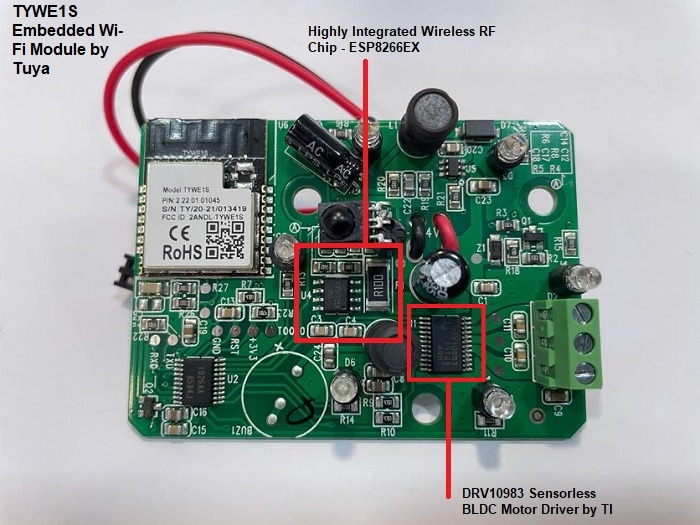
On the other hand, the DRV10983 module uses a sensorless mechanism to provide continuous sinusoidal drive for the motor, which is housed in a separate fan controller board. Atomberg uses an STMicroelectronics fan controller board, which is based on its famous microcontroller, SLIMM-nano.
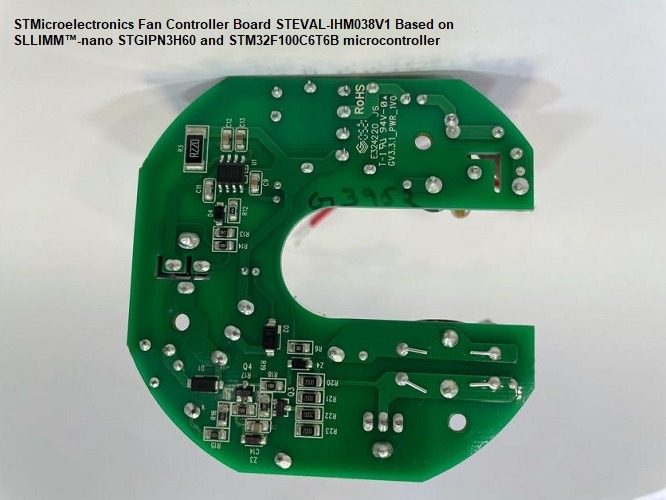
As shown here, all the power electronic components of the fan are housed in the STMicroelectronics-based fan controller board. The assembly shown here is for demonstration only.
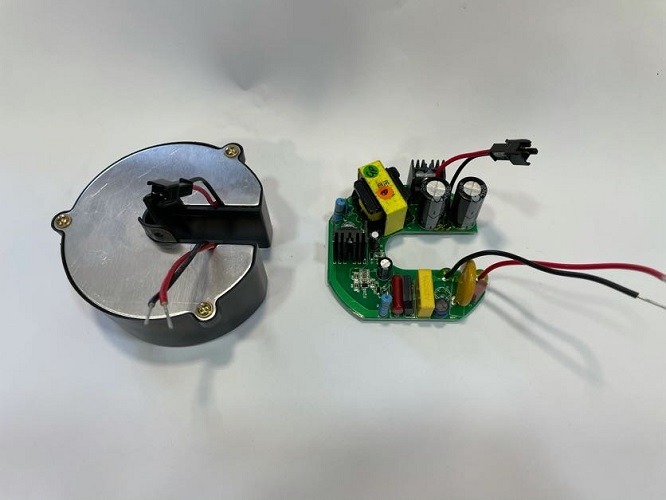
Once the respective components are soldered in place, the Espressif Wi-Fi component module would actively communicate with the fan controller board.
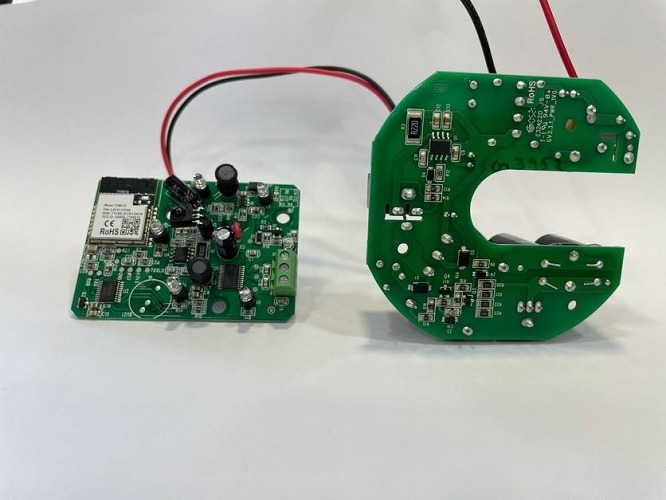
and STMicroelectronics board (for demo only)
The final assembly of Atomberg smart fans integrates multiple evaluation boards and power electronics components. Manoj adds: “Our IoT-enabled fan, Renesa, has a very compact motor and electronic board at the bottom. Also, an LED interface is visible to the user. Whenever the user is controlling the fan from a remote, the LEDs will indicate the speeds at which the fan is set.”
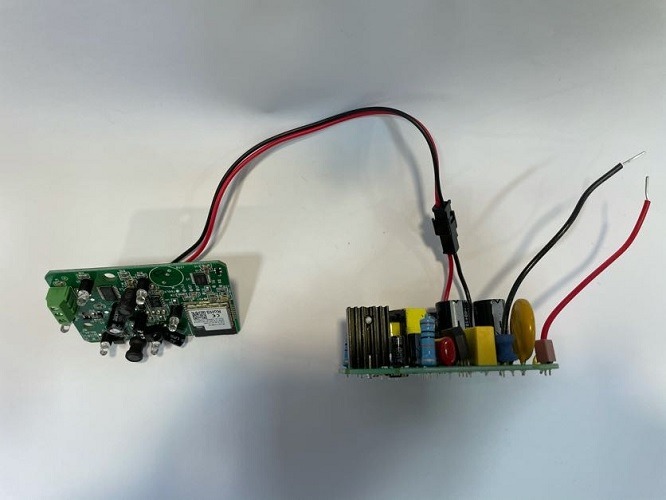
Atomberg IoT Strategy
As a pioneer in smart ceiling fans, Atomberg has a more ambitious strategy for newer smart home products. For example, it is possible that a smart fan may not even depend on Internet connectivity anymore.
Manoj clarifies further, “Today, you need Internet to connect to a Wi-Fi enabled device. But what do you do when there are Internet connectivity issues? That is why we decided to make our product smarter without needing access to Internet. This means our team is now working on offline speech recognition or voice-controlled module. So you don’t need to be connected to the Internet. You don’t need Alexa or even a router. There will be an intelligent chip within the fan along with the mic – will do the speech processing and speech recognition. It will try to decode the commands, and it will be directly regulating the speed.“

Thermostat integration is another area Atomberg is looking into. Instead of a person waking up to turn off a fan, a built-in thermostat can sense the environment and regulate the fan operations. Atomberg, as Manoj confirms, wants to bring the same smart approach to other consumer products, including air-conditioners. Currently, it has plans afoot to bring a smart mixer-grinder to the Indian market by August 2021.
Wi-Fi Ceiling Fans: The Future
Manoj notes that Wi-Fi ceiling fans are going to remain a popular IoT gadget because ceiling fans are widely used. He further insists that Atomberg’s evaluation board and power electronics partners, such as Texas Instruments, NXP, Espressif, and STMicroelectronics are quite happy and satisifed with the partnership. This is on account of the high volumes generated in the smart ceiling fan products. Since India is a big market for consumer electronics products, Manoj sees a huge potential in this strategic product segment.
We believe that given the current pace of development of smart home appliances, consumer demand for various niche products such as smart ceiling fans will continue to grow.







